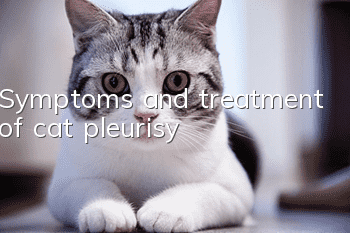Symptoms and treatment of cat pleurisy

When a normally lively cat suddenly stops moving, becomes depressed, has an elevated body temperature, has shallow breathing, etc., you have to wonder whether the cat is suffering from pleurisy. What are the causes of pleurisy in cats? What are they? The causes of cat pleurisy can be divided into two types: primary and secondary.
1. Primary cause
If a cat is hit by a vehicle or falls from a height, it can cause acute pleural contusion, or the chest wall may suffer from gunshot wounds or foreign body punctures, resulting in chest wall penetration and infection.
2. Secondary causes
Mostly it is the spread of chest organ diseases or one of the symptoms of certain diseases. Seen in inflammation of the lungs, mediastinum, pericardium, and lymph nodes; infection after rib or sternum fracture; in the course of certain infectious diseases such as tuberculosis, leptospirosis, feline infectious rhinotracheitis, or feline infectious peritonitis.
Symptoms of cat pleurisy
Cat pleurisy is an inflammatory disease of the pleura characterized by fibrin deposition and large amounts of inflammatory exudate in the chest cavity. In the early stage of the disease, he was depressed, had a loss of appetite, and his body temperature increased by more than 2°C. Breathing is shallow and fast, because there is water or adhesions in the chest, and there may be water sounds and friction sounds on auscultation. On chest percussion, the animal is evasive and sensitive. When there is a large amount of exudation, the fluid accumulates in the chest and compresses the lungs, causing difficulty in breathing and cyanosis of the conjunctiva.
Chronic pleurisy. The symptoms include repeated fever and shortness of breath. If the pleura has extensive adhesion and pleural thickening, the alveolar sounds will be weak or absent during auscultation, and there will be a large area of dullness during percussion.
1. Leakage: caused by congestive heart failure, liver disease, hypoalbuminemia and pulmonary embolism;
2. Change of leakage: caused by pulmonary torsion, diaphragmatic hernia, liver clamping, congestive heart failure or non-shedding tumors blocking lymphatic flow. Change: There are more neutrophils, mesothelial cells and red blood cells in the transudate than in the transudate, and the protein and specific gravity increase;
3. Exudate: It is divided into two types: putrefactive and non-putrefactive exudate. Putrefactive exudate is caused by trauma or perforation, allowing bacteria, fungi, viruses, and parasites to enter the chest cavity; non-putrefactive exudate can be seen in feline infectious peritonitis, pancreatitis, uremia, lung lobe torsion, and new tumors;
4. Tumorous effusion: found in feline thymic lymphosarcoma, metastatic carcinoma and adenocarcinoma in elderly animals, angiosarcoma, cardiac tumors, etc., causing non-corruptible exudate;
5. Chylous effusion: Also called chylothorax, it is seen in congenital thoracic duct abnormalities, thoracic duct tumors and embolism. Feline cardiomyopathy or long-term pleural effusion can cause pseudochylothorax due to cell fragmentation;
6. Pleural hemorrhage: seen in trauma, dicoumarol poisoning, etc.
Treatment measures for cat pleurisy
The treatment of feline pleurisy is mainly based on nursing care. Feline pleurisy can be diagnosed based on clinical symptoms, blood tests and X-ray examinations. The sick cat breathed abdominally, and the chest wall was painful and sensitive to palpation. There is horizontal dullness on percussion and chest rub on auscultation. Thoracentesis may reveal a large amount of yellow, easily coagulated exudate. The blood test showed that the total number of white blood cells was significantly increased, the number of medium-sized granulocytes was increased, the nuclear left shift was obvious, and the lymphocytes were relatively reduced. Fluoroscopic examination shows fluid in the chest cavity, and the fluid fluctuates with respiratory movement.
1. Prevention and Control Measures
Mainly to eliminate inflammation, stop exudation, promote the absorption and elimination of exudate, control infection, and prevent autopoisoning.
1. Promote absorption
In order to promote the absorption of inflammation, 10% camphor alcohol, mustard mud, 6%-7% mustard essence or ammonia liniment and other stimulants can be applied to the chest wall. Diuretics or laxatives can be used if necessary.
2. Stop leakage
In order to prevent large amounts of exudate from the pleural cavity, 10-30 ml of 10% calcium gluconate solution or 5-15 ml of 2%-4% calcium lactate solution can be injected intravenously for several days.
3. Control infection
Antibiotics such as ampicillin, streptomycin, cephalosporins and quinolones can be used.
4. Drain the accumulated fluid
When there is excessive pleural effusion, thoracentesis can be performed to drain the effusion, which can be repeated if necessary. If there is retention of purulent or putrefactive exudate, after removing the fluid, it is advisable to repeatedly flush the chest cavity with 2%-4% boric acid solution or 0.25% procaine penicillin solution.
2. Precautions for diagnosis and treatment
Based on the medical history, clinical symptoms and changes in puncture fluid, the diagnosis is not difficult. However, it must be differentiated from pleural effusion and pericarditis.
1. Pleural effusion: The disease develops slowly, the body temperature of the sick cat is not high, there are no inflammatory changes in the pleura, and the pleural puncture fluid shows a negative Livata reaction.
2. Pericarditis: The sick cat has an increased heartbeat and arrhythmia, and the pericardial friction sound is consistent with the heartbeat.
- A cat will die if it urinates for a few days
- Should you deworm yourself or go to a pet store?
- Are cat teasers harmful to cats?
- What should I do if my cat suffers from chronic gingivitis?
- Cat's nails are cracked with a thin layer
- Cats go crazy after eating mutton
- What does cat moss on a cat’s chin look like?
- Can cats reproduce after abdominal transmission is cured?
- What exactly is the sterilization shot for female cats?
- Can I still eat unopened cat food if it has expired?



